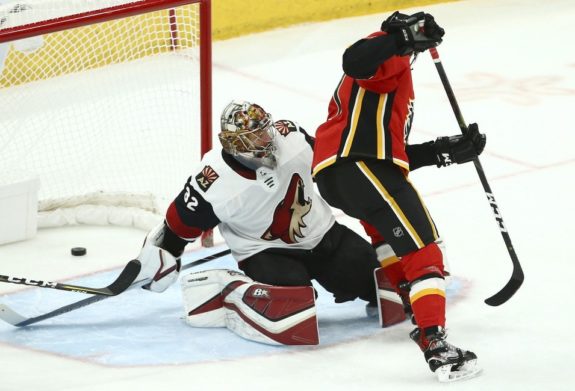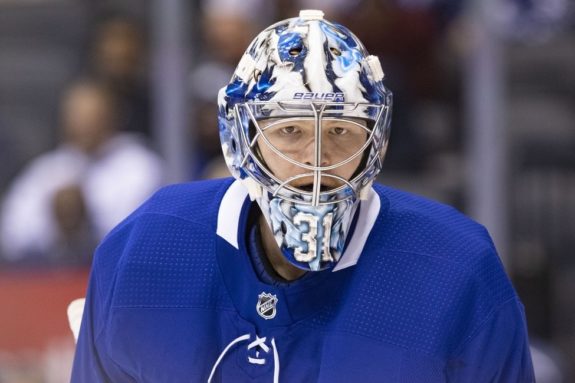When the Carolina Hurricanes traded Alex Nedeljkovic one week ago, there was understandably confusion and dissension among fans. When rumors leaked that Petr Mrazek and James Reimer would also be departing in free agency, the Hurricanes were in a position where they had no goalies under contract for next season.
General manager (GM) Don Waddell had a plan, however, even when Hurricanes fans were losing their minds over the multitude of strange decisions made by head office, and when Day 1 of free agency had concluded, the ‘Canes had landed two proven goalies to create a brand new tandem in net.
Former Arizona Coyote Antti Raanta came first, signing a two-year, $4-million contract. Not long after, 31-year-old Frederik Andersen came on board, also signing for two years, at $9-million.
Obviously GM Waddell and company felt the need to not only shake things up, but go in a completely different direction, even when his goalies last season allowed the fourth-fewest goals-against in the entire NHL. While Mrazek and Reimer had protected the pipes for the past two seasons, rookie Nedeljkovic was seemingly on the come-up and ready to take over when he was abruptly traded.
The goaltending changes are a huge gamble. They’re betting on two guys who have each faced their own unique struggles, and leaving behind three players the Caniacs in Raleigh had really become attached to. The team that was once thought to be a Stanley Cup competitor, now bears all kinds of uncertainty.
Raanta Rolls into Raleigh
So let’s take a look at what we’ve got. Raanta is a 32-year-old goalie from Rauma, Finland, who has 196 games of NHL experience playing for the Chicago Blackhawks, New York Rangers, and Coyotes. His best season came in 2017-18, when he played a career-high 47 games for Arizona, going 21-17-6 with a 2.24 goals-against average (GAA) and .930 save percentage (SV%).
Why is that significant? Because the Coyotes were a terrible team. Only the Buffalo Sabres and Ottawa Senators finished with fewer points than the Coyotes that season, and that was kind of a recurring theme throughout the rest of Raanta’s time in Arizona.

The Coyotes constantly iced a weak team in front of him, often relying on his and Darcy Kuemper‘s goaltending just to keep their heads above water. They actually did make the playoffs in 2020 after defeating the Nashville Predators in the qualifying round, but Kuemper had emerged in more of a starter role at that time. Raanta suited up for just two playoff games before the Coyotes were bounced by the Colorado Avalanche in Round 1.
That’s another concerning statistic about acquiring Raanta – he has just five games of playoff experience in his career spanning eight seasons. He tends to put up pretty good numbers when he can string some games together, but that leads us to the biggest red flag of all – his proneness to injury.
Raanta was limited to just 12 games last season, posting a 5-5-2 record with a 3.36 GAA and .905 SV%. He suffered a lower-body injury in late March, before returning a month later for one game before getting hurt again – this time labeled an upper-body injury. That ended up being the final game he dressed for Arizona, as Raanta sat the final 12 games of the season.
“I think when I hurt my knee and got the surgery, I think after that it just felt like nothing that I was trying to do really worked how I wanted it to. I then started to feel some pinches and things somewhere else other than the knee and when the knee was okay then something else came out. I’ve felt like it’s been like the snowball has been rolling in the wrong direction for a little bit now. I’ve been trying every offseason, every season, to get some new stuff for me and learn from those things what has happened. This offseason I’ve been doing a little bit different things again and hopefully just try to feel good.”
– New Hurricane Antti Raanta on his history of injuries (July 29, 2021) – CanesPR
Raanta’s injury escapades date much further back than just last season. The 32-year-old has missed significant time in each of the last four seasons. Lengthy hospital bills don’t seem to deter Hurricanes management, as proven with the four-year contract they offered Jake Gardiner who had gone through a myriad of back problems in Toronto – issues that still plague him to this day.
Ideally, the Hurricanes hope Raanta can not only maintain his health, but push for the No. 1 goalie position, but it would be foolish to believe Raanta’s body will be magically healed by throwing on a Hurricanes jersey.
If he does run into problems next season, the Hurricanes don’t have much in terms of goaltender depth, so another signing or trade could be on the horizon. For two years at a cap hit of $2-million, Raanta is a fine choice for the backup position if he can stay reasonably healthy, but that’s not something I’d bet the house on.
Hurricanes and Maple Leafs Swap Starters
Waddell and the Hurricanes justified their decision to send Nedeljkovic packing by expressing their desire for a more veteran, established NHL goaltender. They got that in Andersen, who was a very solid starting goalie for the Toronto Maple Leafs over the past five seasons.
Andersen’s body of work with the Maple Leafs includes a 149-74-36 record, 2.79 GAA and .914 SV%. Those numbers have dwindled in recent years, however. Andersen posted a steady SV% above .917 for his first three years in Toronto, but that dipped to .909 in 2019-20, and .895 in 2020-21.

Similarly to Raanta, Andersen (lower body) was shut down last season due to injury. It was speculated he was playing through the issues early on in the season, which could have contributed to his lacking play, but when Jack Campbell emerged as Toronto’s starter, it afforded Andersen some much-needed rest. For the remainder of the season, Andersen mostly sat as Campbell took over the net, playing one final game on May 12 – his last in a Maple Leafs jersey.
While Andersen doesn’t quite carry the same risk as Raanta when it comes to his history of injuries, it’s mostly his age and declining numbers that are concerning. His best years in Toronto were his early ones, when the Maple Leafs’ defense was notoriously awful. They fortified that area going into last season, and it should have helped boost his play, but it seemed to have the opposite effect.
He wasn’t a spectacular or reliable goalie last season, and we can chalk that up to pains and tweaks that caused him to eventually sit out the rest of the season, but the fact remains that his overall play the last two years has been largely inconsistent.
Stylistically, Andersen is a steady presence in net. He has a much calmer demeanor than the fiery Petr Mrazek, who he swapped teams with this summer, and his large 6-foot-4, 238-pound frame is an asset in goal. At his best, Andersen is a fantastic puck stopper who should theoretically excel behind the impenetrable Hurricanes defense. But there’s really no telling which Andersen the Hurricanes are going to get.
He’ll be 32 at the start of next season. Injuries aren’t the major concern with Andersen, it’s more his level of consistency for $4.5-million per year – a significantly higher price than what Mrazek ($3.8-million) and Nedeljkovic ($3-million) signed for. We’re back to an 82-game schedule, and the Hurricanes have two goalies who have a lot of question marks about their gameplay with no safety net to fall back on. Last season was a sprint, this season is a marathon, and the Hurricanes just don’t look prepared for it.
Hurricanes Have Made a Clear Downgrade in Goal
With all due respect to the veterans Andersen and Raanta, it’s hard to believe the Hurricanes have made an upgrade in goal. Management elected to move on from a fan-favorite starter in 29-year-old Mrazek, who was terrific in limited starts last season, for two downward-trending goalies creeping into their mid-30s.
They gave up on budding 25-year-old Nedeljkovic, a Calder Trophy finalist who had spent seven long, grueling years within the organization, and traded him for a third-round pick. He committed so much of his career to the Hurricanes, won a Calder Cup with the AHL’s Charlotte Checkers, and at his first sign of success, the Hurricanes blindside him.
Nedeljkovic could fizzle out in Detroit, or he could go on to become a star. But I think fans are going to look back on this trade as a huge mistake. He was eligible for arbitration, which likely complicated negotiations even further, but the two-year, $6-million contract he signed with the Detroit Red Wings was easily matchable. Even if he couldn’t fully replicate last season’s success, it’s a tradeable contract with a stomachable average annual value (AAV).
The combined cap hits of Nedeljkovic and Mrazek’s new contracts is $6.8-million per season, and the Hurricanes are paying their new tandem $6.5-million annually, so there’s not a huge difference there. They may have pocketed some extra change, but their new duo is a combined nine years older, with no more playoff success than what Mrazek and Nedeljkovic have done in their short time in Carolina.
Something needed to change with the Hurricanes – that was clear. Three years in a row, they got blitzed by a stronger team in the playoffs. But the main problem for the Hurricanes in the 2021 playoffs wasn’t goaltending – it was scoring – and they still haven’t addressed that area yet.
Nedeljkovic wasn’t perfect. He’s got exceptional athleticism and he’s a great puck handler, but he had his flaws and it’s important to acknowledge that. But looking back, it feels like even with his spectacular run last season, the Hurricanes had already made up their minds to move on from him. It leads me to believe that nothing – perhaps only a Stanley Cup – could have saved Nedeljkovic.
A change of scenery typically only benefits players when they’re offered the opportunity to contribute on a larger scale in ways they weren’t given before. Perhaps Andersen will be fired up after so many years of postseason failure with the Maple Leafs. He’ll have a better defense in front of him than he did in Toronto, but he still needs to come up clutch in those big moments. The Hurricanes are betting on him to be that man.
The topic of goaltending is going to be exhausted over the course of next season, and that’s because these drastic changes were so polarizing. Controversial moves come with microscopic criticism, and in a position as isolating as a goaltender, you have to come to expect judgment. Waddell and company chose to go out of their way to dismantle the position. It’s now on Andersen and Raanta to prove them right.